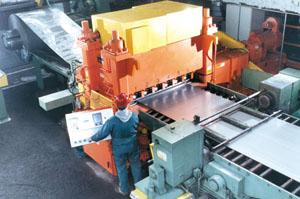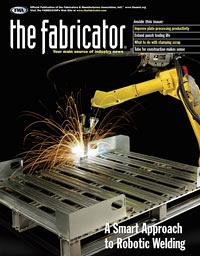Contributing Writer
- FMA
- The Fabricator
- FABTECH
- Canadian Metalworking
Categories
- Additive Manufacturing
- Aluminum Welding
- Arc Welding
- Assembly and Joining
- Automation and Robotics
- Bending and Forming
- Consumables
- Cutting and Weld Prep
- Electric Vehicles
- En Español
- Finishing
- Hydroforming
- Laser Cutting
- Laser Welding
- Machining
- Manufacturing Software
- Materials Handling
- Metals/Materials
- Oxyfuel Cutting
- Plasma Cutting
- Power Tools
- Punching and Other Holemaking
- Roll Forming
- Safety
- Sawing
- Shearing
- Shop Management
- Testing and Measuring
- Tube and Pipe Fabrication
- Tube and Pipe Production
- Waterjet Cutting
Industry Directory
Webcasts
Podcasts
FAB 40
Advertise
Subscribe
Account Login
Search
Correcting shape problems in flat-rolled coil
Defining simple and complex shape defects
- By Bill Weber
- October 11, 2001
- Article
- Bending and Forming
Flattener Designs
Flatteners can be spread-center or close-center machines (see Figure 1 and Figure 2). The rolls on spread-center machines generally are separated by more than one roll diameter so that the top bank of rolls can pass down through the bottom bank of rolls. A close-center machine's rolls are spaced so that the top rolls do not fit between the bottom rolls.
Spread-center machines seldom are backed up, while close-center machines may or may not be backed up. Backed-up flatteners tend to deflect less, minimizing edge wave damage to the strip. They can have smaller rolls on tighter centers, allowing them to process thinner material and correct crossbow more easily.
Flatteners cannot flex their work rolls, which distinguishes them from levelers. While flatteners can have any number of rolls, they typically have three, four, five, seven, or nine. Three- and four-roll flatteners usually are used only for threading side trimming or slitting lines.
Four-roll flatteners are a common modification to three-roll flatteners because they allow the material to be turned back down if it has been turned up too much. Five-, seven-, and nine-roll flatteners typically are used in lines that have no other flattening device and are run continuously, not just during threading.
A three-roll flattener can remove coil set but not crossbow. Crossbow removal requires a severe reverse bend, so with a three-roll machine, the material comes out turned up by the time the crossbow is removed.
Multiple-roll flatteners can remove crossbow and are easier to set than a three-roll flattener because the material does not need to be made flat with the last bend. In a multiple-roll flattener, the material may be made flat partway through the machine while worked elastically only with the last few bends because of the tapered nest.
Leveler Designs
Levelers, like flatteners, have varying configurations, with the following main differences:
- Size. In general, the larger a machine is, the fewer rolls it has. There are two reasons for this. First, heavier material generally has less complex shape defects and requires less differential path length to correct. Second, adding rolls requires more bearings, a larger top frame and components to handle increased separating loads, more spindles, gears, motor power, etc., all of which add to the cost.
- Top frame. Levelers come with hydraulic or mechanical top frame components. Mechanical machines seem best-suited to materials less than 5/8 in. thick because components for machines that process material in this size range are readily available and tend to be less maintenance-intensive.
For materials more than 5/8 in. thick, hydraulic machines can be more practical because larger hydraulic components are more readily available and tend to have lower maintenance costs. Mechanical design components of this size usually are custom-designed and -manufactured. - Backup design. Levelers have either wedge-supported or hydraulic-supported backup designs (see Figure 3). The hydraulic backup maintains a flat exit roll, while the wedge backup design shapes the exit and entry rolls. Shaping the exit rolls enables a machine to create a longer differential path length and therefore enhances its leveling capability.
Other key elements to be considered when comparing levelers are:
- Roll spacing. In general, closer is better, but it limits spindle outer diameter and strength, which can diminish motor power and design safety factors.
- Backup bearing diameter. Usually bigger is better, but this conflicts with roll spacing.
- Backup flight spacing. Closer flight spacing results in higher capacity.
- Top frame components. Larger components result in higher capacity.
- Motor power. More power is better, to a point; a motor with too much power can overload a machine.
- U-joint size. Bigger is always better, but it sacrifices roll spacing.
Matching the Defect to the Machine
For correcting the simple shape defects of coil set, crossbow, and twist, flatteners are a suitable choice. Their rolls cannot be shaped, so they can correct these defects, which are characterized by length variations across the thickness of the strip.
For correcting complex shape defects, such as edge wave, buckle, saddle, and dish, levelers are an appropriate choice. Leveler rolls can be shaped, so they can correct these defects, which are length variations across the width of the strip instead of or in addition to length variations across the thickness of the strip.
Finally, only a tension leveler can correct the complex shape defect of camber, which is a linear length variation across the entire width of the strip.
About the Author
subscribe now

The Fabricator is North America's leading magazine for the metal forming and fabricating industry. The magazine delivers the news, technical articles, and case histories that enable fabricators to do their jobs more efficiently. The Fabricator has served the industry since 1970.
start your free subscription- Stay connected from anywhere

Easily access valuable industry resources now with full access to the digital edition of The Fabricator.

Easily access valuable industry resources now with full access to the digital edition of The Welder.

Easily access valuable industry resources now with full access to the digital edition of The Tube and Pipe Journal.
- Podcasting
- Podcast:
- The Fabricator Podcast
- Published:
- 04/16/2024
- Running Time:
- 63:29
In this episode of The Fabricator Podcast, Caleb Chamberlain, co-founder and CEO of OSH Cut, discusses his company’s...
- Trending Articles
How to set a press brake backgauge manually

Capturing, recording equipment inspection data for FMEA

Tips for creating sheet metal tubes with perforations

Are two heads better than one in fiber laser cutting?

Hypertherm Associates implements Rapyuta Robotics AMRs in warehouse

- Industry Events
16th Annual Safety Conference
- April 30 - May 1, 2024
- Elgin,
Pipe and Tube Conference
- May 21 - 22, 2024
- Omaha, NE
World-Class Roll Forming Workshop
- June 5 - 6, 2024
- Louisville, KY
Advanced Laser Application Workshop
- June 25 - 27, 2024
- Novi, MI




























